Research on Monocrystalline Silicon Micro-Nano Structures Irradiated by Femtosecond Laser
Abstract
1. Introduction
2. Theoretical Background
3. Experimental Processes and Sample Tests
3.1. Materials and Laser Irradiation
3.2. Characterization
4. Results and Discussion
4.1. Ultrafast Electron and Lattice Dynamics
4.2. Surface Micro-Nano Structure Characteristics
4.3. Phase Transition Mechanism
5. Conclusions
Author Contributions
Funding
Institutional Review Board Statement
Informed Consent Statement
Data Availability Statement
Conflicts of Interest
References
- Akinwande, D.; Huyghebaert, C.; Wang, C.-H.; Serna, M.I.; Goossens, S.; Li, L.-J.; Wong, H.S.P.; Koppens, F.H.L. Graphene and two-dimensional materials for silicon technology. Nature 2019, 573, 507–518. [Google Scholar] [CrossRef] [PubMed]
- Kumar, K.; Lee, K.; Herman, P.R.; Nogami, J.; Kherani, N.P. Femtosecond laser direct hard mask writing for selective facile micron-scale inverted-pyramid patterning of silicon. Appl. Phys. Lett. 2012, 101, 222106. [Google Scholar] [CrossRef]
- Randall, J.; Lyding, J.; Schmucker, S.; Ehr, J.; Ballard, J.; Saini, R.; Xu, H.; Ding, Y. Atomic precision lithography on Si. J. Vac. Sci. Technol. B Microelectron. Nanometer Struct. 2009, 27, 2764–2768. [Google Scholar] [CrossRef]
- Hung, N.P.; Fu, Y.Q.; Ali, M.Y. Focused ion beam machining of silicon. J. Mater. Process. Technol. 2002, 127, 256–260. [Google Scholar] [CrossRef]
- Gattass, R.R.; Mazur, E. Femtosecond laser micromachining in transparent materials. Nat. Photonics 2008, 2, 219–225. [Google Scholar] [CrossRef]
- Bisht, A.; Kalsar, R.; Adak, A.; Dey, I.; Jana, K.; Lad, A.; Kumar, G.R.; Jagadeesh, G.; Suwas, S. Observation of ex-situ microstructure relaxation of non-conventional misorientations post femtosecond laser shock exposure in cp-Ti. Acta Mater. 2018, 150, 161–172. [Google Scholar] [CrossRef]
- Mahdieh, M.H.; Gharibzadeh, M. 3-Dimensional simulation and footprint of optical breakdown in dielectrics induced by femtosecond laser pulse. Opt. Laser Technol. 2012, 44, 1713–1721. [Google Scholar] [CrossRef]
- Yong, J.; Bai, X.; Yang, Q.; Hou, X.; Chen, F. Filtration and removal of liquid polymers from water (polymer/water separation) by use of the underwater superpolymphobic mesh produced with a femtosecond laser. J. Colloid Interface Sci. 2021, 582, 1203–1212. [Google Scholar] [CrossRef]
- Chen, Y.; Cao, Y.; Wang, Y.; Zhang, L.; Shao, G.; Zi, J. Fabrication of grooves on polymer-derived SiAlCN ceramics using femtosecond laser pulses. Ceram. Int. 2020, 46, 11747–11761. [Google Scholar] [CrossRef]
- Sun, T.; Huo, J.; Xiao, Y.; Liu, L.; Feng, B.; Zhai, X.; Wang, W.; Zou, G. Atomic Bonding-Engineered Heterogeneous Integration of Semiconductor Nanowires by Femtosecond Laser Irradiation for a Miniaturized Photodetector. Appl. Surf. Sci. 2021, 575, 151709. [Google Scholar] [CrossRef]
- Okano, K.; Hsu, H.-Y.; Li, Y.-K.; Masuhara, H. In situ patterning and controlling living cells by utilizing femtosecond laser. J. Photochem. Photobiol. C Photochem. Rev. 2016, 28, 1–28. [Google Scholar] [CrossRef]
- Ali, B.; Litvinyuk, I.V.; Rybachuk, M. Femtosecond laser micromachining of diamond: Current research status, applications and challenges. Carbon 2021, 179, 209–226. [Google Scholar] [CrossRef]
- Huang, M.; Zhao, F.; Cheng, Y.; Xu, N.; Xu, Z. Origin of Laser-Induced Near-Subwavelength Ripples: Interference between Surface Plasmons and Incident Laser. ACS Nano 2009, 3, 4062–4070. [Google Scholar] [CrossRef] [PubMed]
- Stephan, G.F.; Clemens, K.; Sebastian, E.; Thibault, D.; Frank, M. Femtosecond Laser-Induced Periodic Surface Structures on Fused Silica: The Impact of the Initial Substrate Temperature. Materials 2018, 11, 1340. [Google Scholar]
- Liang, F.; Vallée, R.; Chin, S.L. Mechanism of nanograting formation on the surface of fused silica. Opt. Express 2012, 20, 4389–4396. [Google Scholar] [CrossRef]
- Rebollar, E.; Castillejo, M.; Ezquerra, T.A. Laser induced periodic surface structures on polymer films: From fundamentals to applications. Eur. Polym. J. 2015, 73, 162–174. [Google Scholar] [CrossRef]
- Zhang, D.; Liu, R.; Li, Z. Irregular LIPSS produced on metals by single linearly polarized femtosecond laser. Int. J. Extrem. Manuf. 2022, 4, 015102. [Google Scholar] [CrossRef]
- Sokolowski-Tinten, K.; Bonse, J.; Barty, A.; Chapman, H.; Bajt, S.; Bogan, M.; Boutet, S.; Cavalleri, A.; Düsterer, s.; Frank, M.; et al. In-situ observation of the formation of laser-induced periodic surface structures with extreme spatial and temporal resolution. arXiv 2022, arXiv:2206.04556. [Google Scholar]
- Driel, H.; Young, J.F.; Sipe, J.E. Laser Induced Periodic Surface Structure: An Experimental And Theoretical Review. Mrs Online Proc. Libr. Arch. 1982, 13, 302–318. [Google Scholar]
- Sipe, J.E.; Driel, H. Laser Induced Periodic Surface Structure: An Experimental And Theoretical Review. In Proceedings of the Trends in Quantum Electronics, Bucharest, Romania, 29 August–3 September 1989. [Google Scholar]
- Bonse, J.; Rosenfeld, A.; Krüger, J. Implications of transient changes of optical and surface properties of solids during femtosecond laser pulse irradiation to the formation of laser-induced periodic surface structures. Appl. Surf. Sci. 2011, 257, 5420–5423. [Google Scholar] [CrossRef]
- Zhang, D.; Ranjan, B.; Tanaka, T.; Sugioka, K. Carbonized Hybrid Micro/Nanostructured Metasurfaces Produced by Femtosecond Laser Ablation in Organic Solvents for Biomimetic Antireflective Surfaces. ACS Appl. Nano Mater. 2020, 3, 1855–1871. [Google Scholar] [CrossRef]
- Tsibidis, G.D.; Skoulas, E.; Papadopoulos, A.; Stratakis, E. Convection roll-driven generation of supra-wavelength periodic surface structures on dielectrics upon irradiation with femtosecond pulsed lasers. Phys. Rev. B 2016, 94, 081305. [Google Scholar] [CrossRef]
- Zhang, D.S.; Li, X.Z.; Fu, Y.; Yao, Q.H.; Li, Z.G. Koji Sugioka Liquid vortexes and flows induced by femtosecond laser ablation in liquid governing formation of circular and crisscross LIPSS. Opto Electron. Adv. 2022, 5, 210066. [Google Scholar] [CrossRef]
- Abou Saleh, A. Relationship between Selforganization and Creation/Resorption of Microstructural Defects under Ultrashort Laser Irradiation. Ph.D. Thesis, University Jean Monnet, Lyon, France, 2020. [Google Scholar]
- Rapp, L.; Haberl, B.; Pickard, C.J.; Bradby, J.E.; Gamaly, E.G.; Williams, J.S.; Rode, A.V. Experimental evidence of new tetragonal polymorphs of silicon formed through ultrafast laser-induced confined microexplosion. Nat. Commun. 2015, 6, 7555. [Google Scholar] [CrossRef]
- Tan, D.; Sharafudeen, K.N.; Yue, Y.; Qiu, J. Femtosecond laser induced phenomena in transparent solid materials: Fundamentals and applications. Prog. Mater. Sci. 2016, 76, 154–228. [Google Scholar] [CrossRef]
- Bonse, J.; Grf, S. Maxwell Meets Marangoni—A Review of Theories on Laser—Induced Periodic Surface Structures. Laser Photonics Rev. 2020, 14, 2000215. [Google Scholar] [CrossRef]
- Juodkazis, S.; Nishimura, K.; Tanaka, S.; Misawa, H.; Gamaly, E.G.; Luther-Davies, B.; Hallo, L.; Nicolai, P.; Tikhonchuk, V.T. Laser-Induced Microexplosion Confined in the Bulk of a Sapphire Crystal: Evidence of Multimegabar Pressures. Phys. Rev. Lett. 2006, 96, 166101. [Google Scholar] [CrossRef] [PubMed]
- Gamaly, E.G.; Rapp, L.; Roppo, V.; Juodkazis, S.; Rode, A.V. Generation of high energy density by fs-laser-induced confined microexplosion. New J. Phys. 2013, 15, 025018. [Google Scholar] [CrossRef]
- Zhao, J.H.; Li, X.B.; Chen, Q.D.; Chen, Z.G.; Sun, H.B. Ultrafast laser induced black silicon, from micro-nanostructuring, infrared absorption mechanism, to high performance detecting devices. Mater. Today Nano 2020, 11, 100078. [Google Scholar] [CrossRef]
- Levy, Y.; Derrien, T.J.Y.; Bulgakova, N.M.; Gurevich, E.L.; Mocek, T. Relaxation dynamics of femtosecond-laser-induced temperature modulation on the surfaces of metals and semiconductors. Appl. Surf. Sci. 2016, 374, 157–164. [Google Scholar] [CrossRef]
- Tsibidis, G.D.; Barberoglou, M.; Loukakos, P.A.; Stratakis, E.; Fotakis, C. Dynamics of ripple formation on silicon surfaces by ultrashort laser pulses in sub-ablation conditions. arXiv 2011, arXiv:1109.2568. [Google Scholar]
- Tsibidis, G.D.; Stratakis, E. Ripple formation on silver after irradiation with radially polarised ultrashort-pulsed lasers. J. Appl. Phys. 2017, 121, 163106. [Google Scholar] [CrossRef]
- Anisimov, S.I.; Kapeliovich, B.L.; Perel’Man, T.L. Electron emission from metal surface exposed to ultrashort laser pulses. Sov. J. Exp. Theor. Phys. 1974, 39, 375–377. [Google Scholar]
- Bulgakova, N.M.; Stoian, R.; Rosenfeld, A.; Marine, W.; Campbell, E.E.B. A general continuum approach to describe fast electronic transport in pulsed laser irradiated materials: The problem of Coulomb explosion. Int. Soc. Opt. Photonics 2005, 81, 345–356. [Google Scholar] [CrossRef]
- Sipe, J.E.; Young, J.F.; Preston, J.S.; van Driel, H.M. Laser-induced periodic surface structure. I. Theory. Phys. Rev. B 1983, 27, 1141–1154. [Google Scholar] [CrossRef]
- Bäuerle, D. Laser Processing and Chemistry; Springer: Berlin/Heidelberg, Germany, 2011. [Google Scholar]
- Sokolowski-Tinten, K.; von der Linde, D. Generation of dense electron-hole plasmas in silicon. Phys. Rev. B 2000, 61, 2643–2650. [Google Scholar] [CrossRef]
- Colombier, J.-P.; Rudenko, A.; Silaeva, E.; Zhang, H.; Sedao, X.; Bévillon, E.; Reynaud, S.; Maurice, C.; Pigeon, F.; Garrelie, F.; et al. Mixing periodic topographies and structural patterns on silicon surfaces mediated by ultrafast photoexcited charge carriers. Phys. Rev. Res. 2020, 2, 043080. [Google Scholar] [CrossRef]
- Quiroga-González, E.; Carstensen, J.; Glynn, C.; O’Dwyer, C.; Föll, H. Pore size modulation in electrochemically etched macroporous p-type silicon monitored by FFT impedance spectroscopy and Raman scattering. Phys. Chem. Chem. Phys. Camb. R. Soc. Chem. 2014, 16, 255–263. [Google Scholar] [CrossRef]
- Miyazaki, K.; Miyaji, G. Periodic Nanostructure Formation on Silicon Irradiated with Multiple Low-fluence Femtosecond Laser Pulses in Water. Phys. Procedia 2012, 39, 674–682. [Google Scholar] [CrossRef]
- Izawa, Y.; Izawa, Y.; Setsuhara, Y.; Hashida, M.; Fujita, M.; Sasaki, R.; Nagai, H.; Yoshida, M. Ultrathin amorphous Si layer formation by femtosecond laser pulse irradiation. Applied Physics Letters 2007, 90, 044107. [Google Scholar] [CrossRef]
- Florian, C.; Fischer, D.; Freiberg, K.; Duwe, M.; Bonse, J. Single Femtosecond Laser-Pulse-Induced Superficial Amorphization and Re-Crystallization of Silicon. Materials 2021, 14, 1651. [Google Scholar] [CrossRef] [PubMed]
- Wen, C.; Yang, Y.J.; Ma, Y.J.; Shi, Z.Q.; Wang, Z.J.; Mo, J.; Li, T.C.; Li, X.H.; Hu, S.F.; Yang, W.B. Sulfur-hyperdoped silicon nanocrystalline layer prepared on polycrystalline silicon solar cell substrate by thin film deposition and nanosecond-pulsed laser irradiation. Appl. Surf. Sci. 2019, 476, 49–60. [Google Scholar] [CrossRef]
- Bonse, J.; Brzezinka, K.W.; Meixner, A.J. Modifying single-crystalline silicon by femtosecond laser pulses: An analysis by micro Raman spectroscopy, scanning laser microscopy and atomic force microscopy. Appl. Surf. Sci. 2004, 221, 215–230. [Google Scholar] [CrossRef]
- Crawford, T.; Yamanaka, J.; Botton, G.A.; Haugen, H.K. High-resolution observations of an amorphous layer and subsurface damage formed by femtosecond laser irradiation of silicon. J. Appl. Phys. 2008, 103, 215–453. [Google Scholar] [CrossRef]
- Schade, M.; Varlamova, O.; Reif, J.; Blumtritt, H.; Erfurth, W.; Leipner, H.S. High-resolution investigations of ripple structures formed by femtosecond laser irradiation of silicon. Anal. Bioanal. Chem. 2010, 396, 1905–1911. [Google Scholar] [CrossRef]
- Feng, Q.; Picard, Y.N.; Liu, H.; Yalisove, S.M.; Mourou, G.; Pollock, T.M. Femtosecond laser micromachining of a single-crystal superalloy. Scr. Mater. 2005, 53, 511–516. [Google Scholar] [CrossRef]
- Schoenfelder, S.; Bagdahn, J.; Baumann, S.; Kray, D.; Christiansen, S. Strength Characterization of Laser Diced Silicon for Application in Solar Industry. In Proceedings of the 21st European Photovoltaic Solar Energy Conference, Dresden, Germany, 4–8 September 2006. [Google Scholar]
- Amer, M.S.; Dosser, L.; LeClair, S.; Maguire, J.F. Induced stresses and structural changes in silicon wafers as a result of laser micro-machining. Appl. Surf. Sci. 2002, 187, 291–296. [Google Scholar] [CrossRef]
- Sokolowski-Tinten, K.; Bialkowski, J.; Cavalleri, A.; von der Linde, D.; Oparin, A.; Meyer-Ter-Vehn, J.; Anisimov, S. Transient States of Matter during Short Pulse Laser Ablation. Phys. Rev. Lett. 1998, 81, 224–227. [Google Scholar] [CrossRef]
- Borowiec, A.; Bruce, D.M.; Cassidy, D.T.; Haugen, H.K. Imaging the strain fields resulting from laser micromachining of semiconductors. Appl. Phys. Lett. 2003, 83, 225–227. [Google Scholar] [CrossRef]
- Smith, M.; Sher, M.-J.; Franta, B.; Lin, Y.-T.; Mazur, E.; Gradečak, S. The origins of pressure-induced phase transformations during the surface texturing of silicon using femtosecond laser irradiation. J. Appl. Phys. 2012, 112, 083518. [Google Scholar] [CrossRef]
- Smith, M.; Lin, Y.-T.; Sher, M.-J.; Winkler, M.; Mazur, E.; Gradečak, S. Pressure-induced phase transformations during femtosecond-laser doping of silicon. J. Appl. Phys. 2011, 110, 053524. [Google Scholar] [CrossRef]
- Cavalleri, A.; Sokolowski-Tinten, K.; Bialkowski, J.; Schreiner, M.; von der Linde, D. Femtosecond melting and ablation of semiconductors studied with time of flight mass spectroscopy. J. Appl. Phys. 1999, 85, 3301–3309. [Google Scholar] [CrossRef]


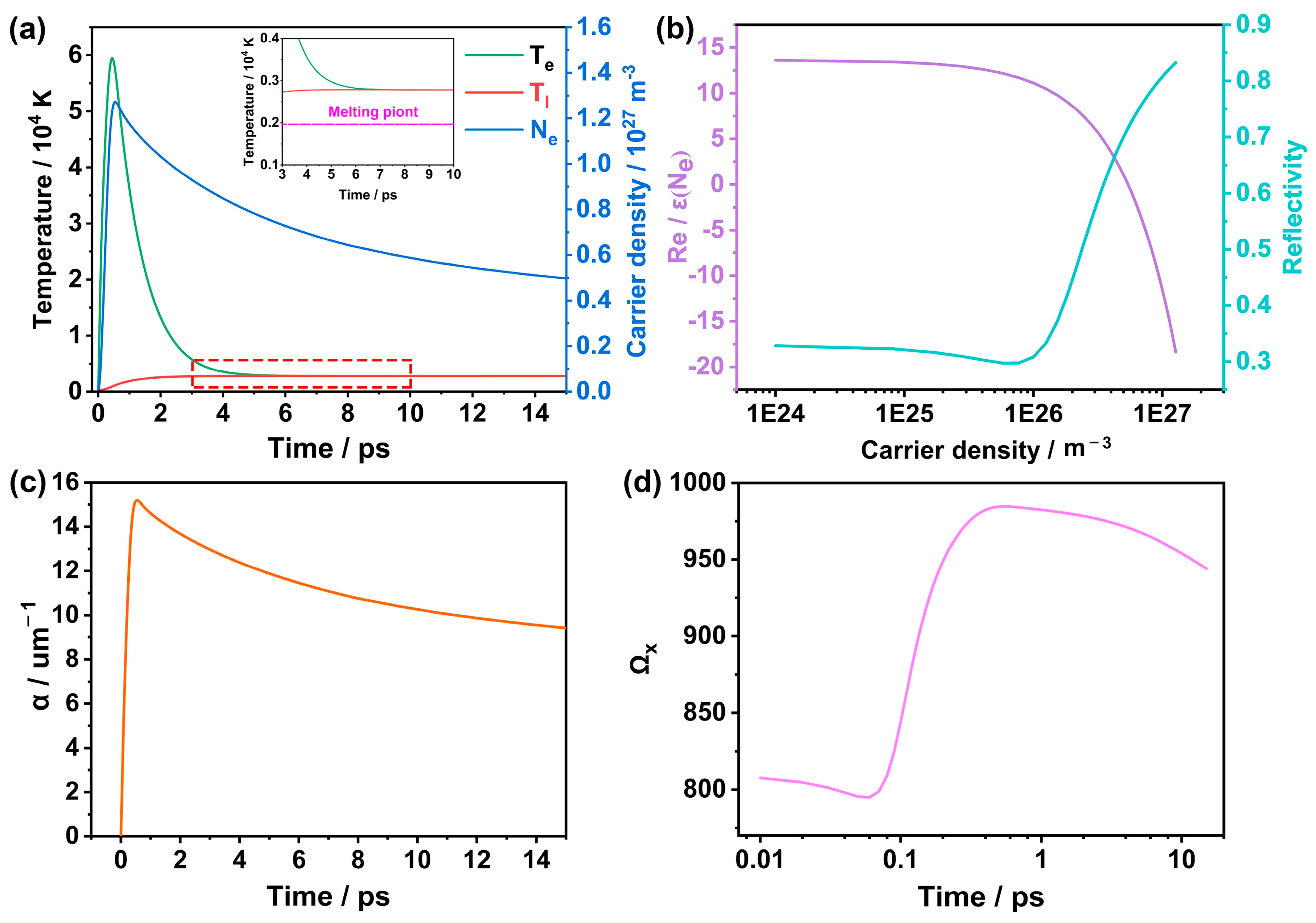
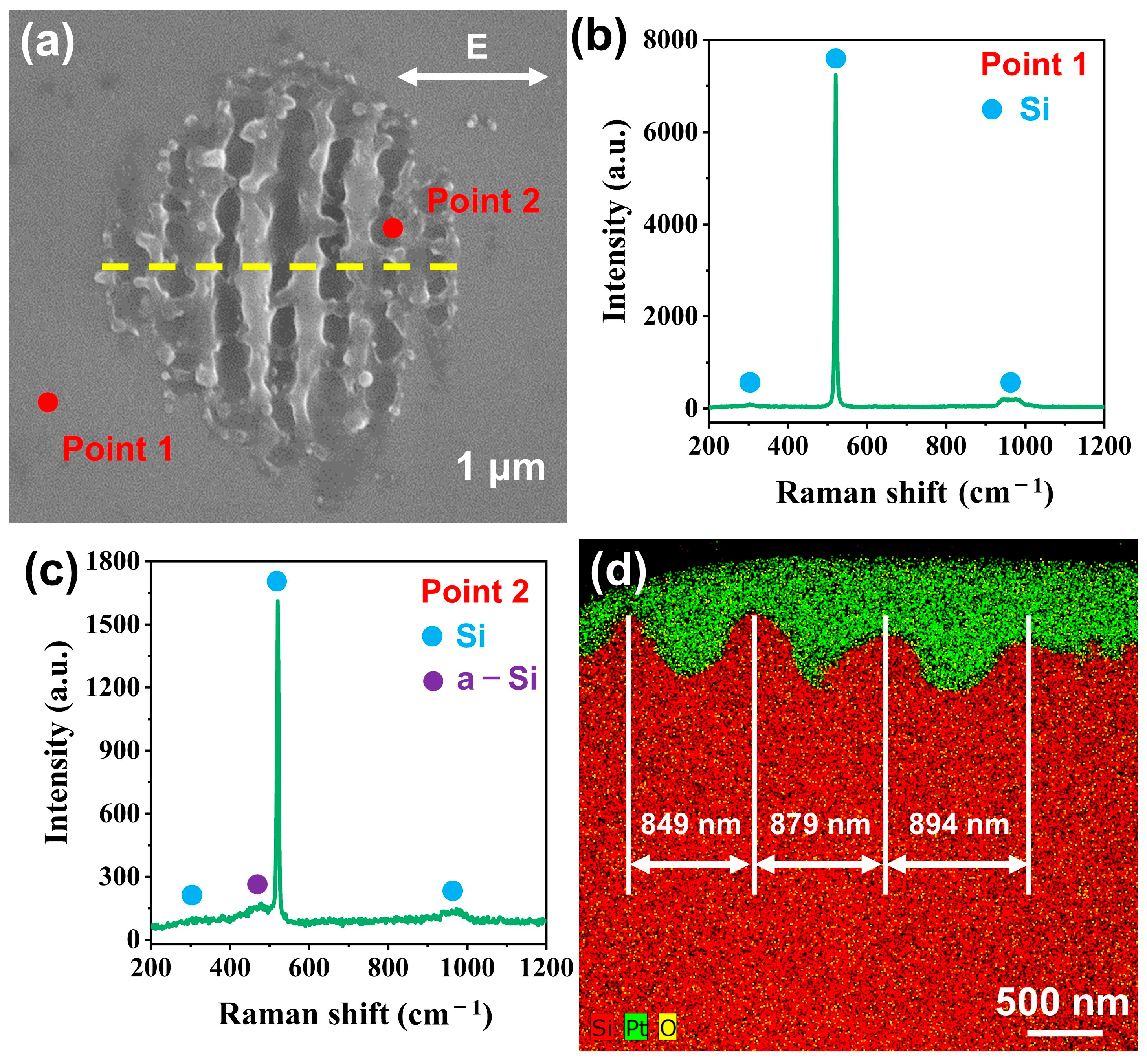
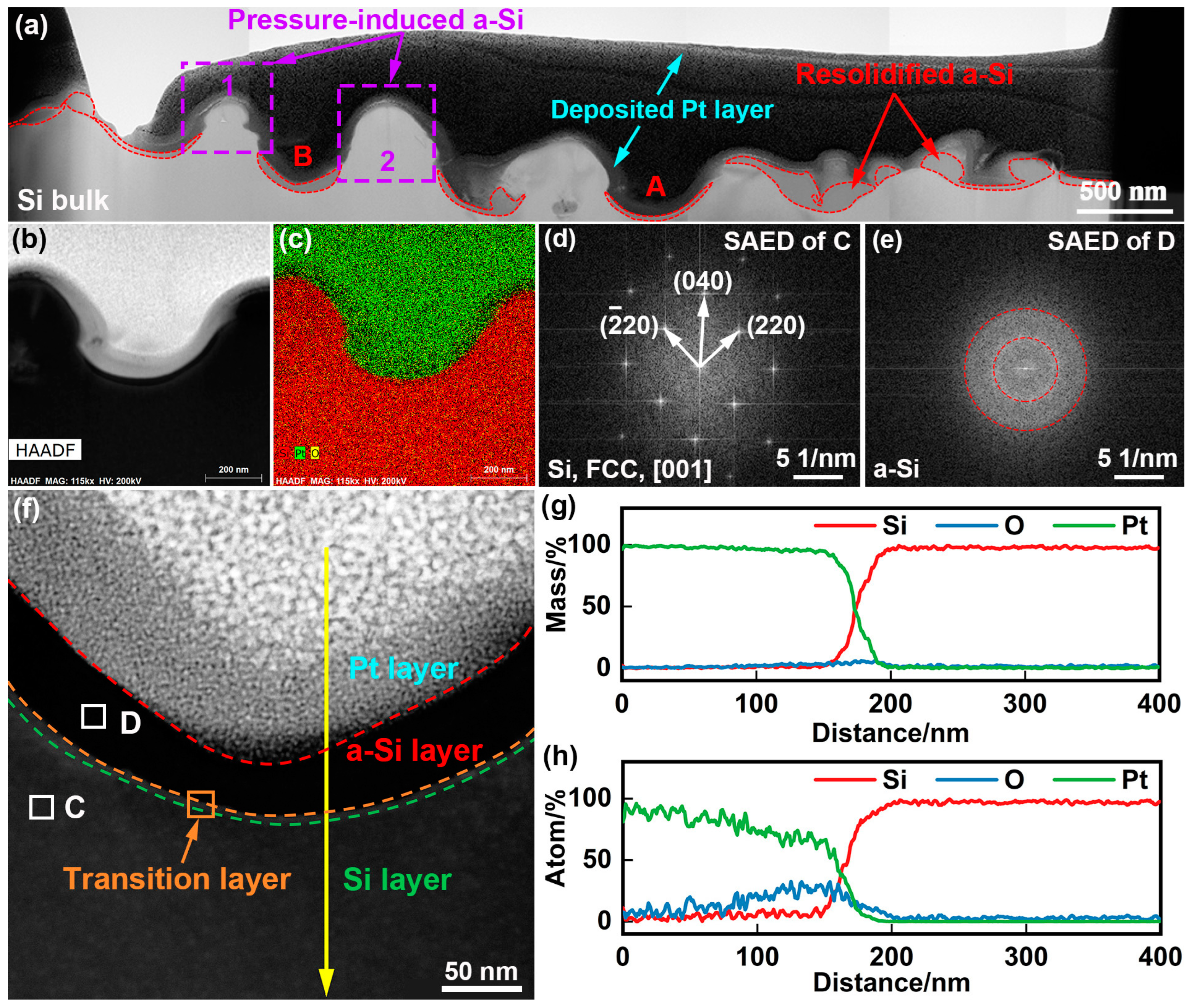
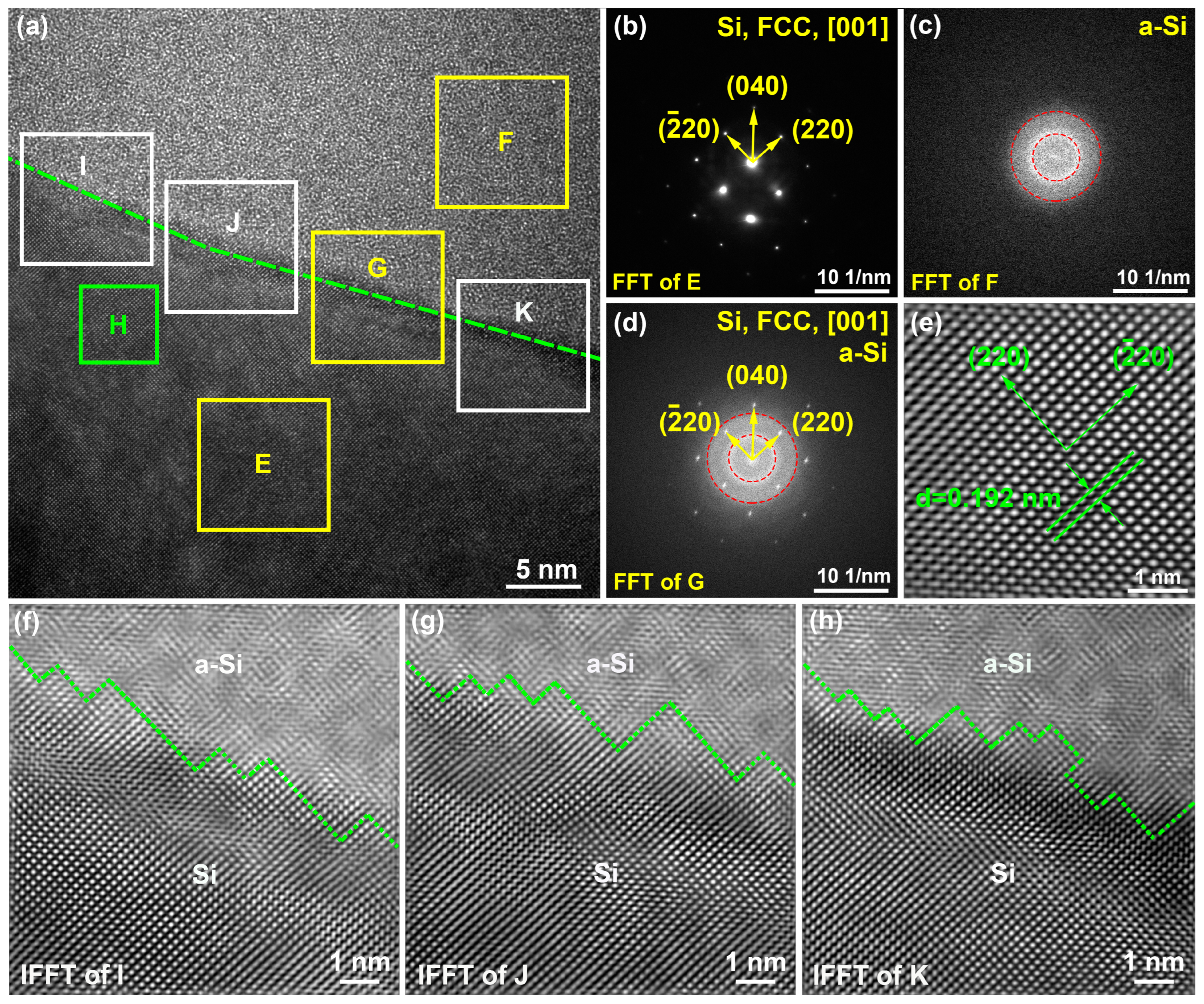
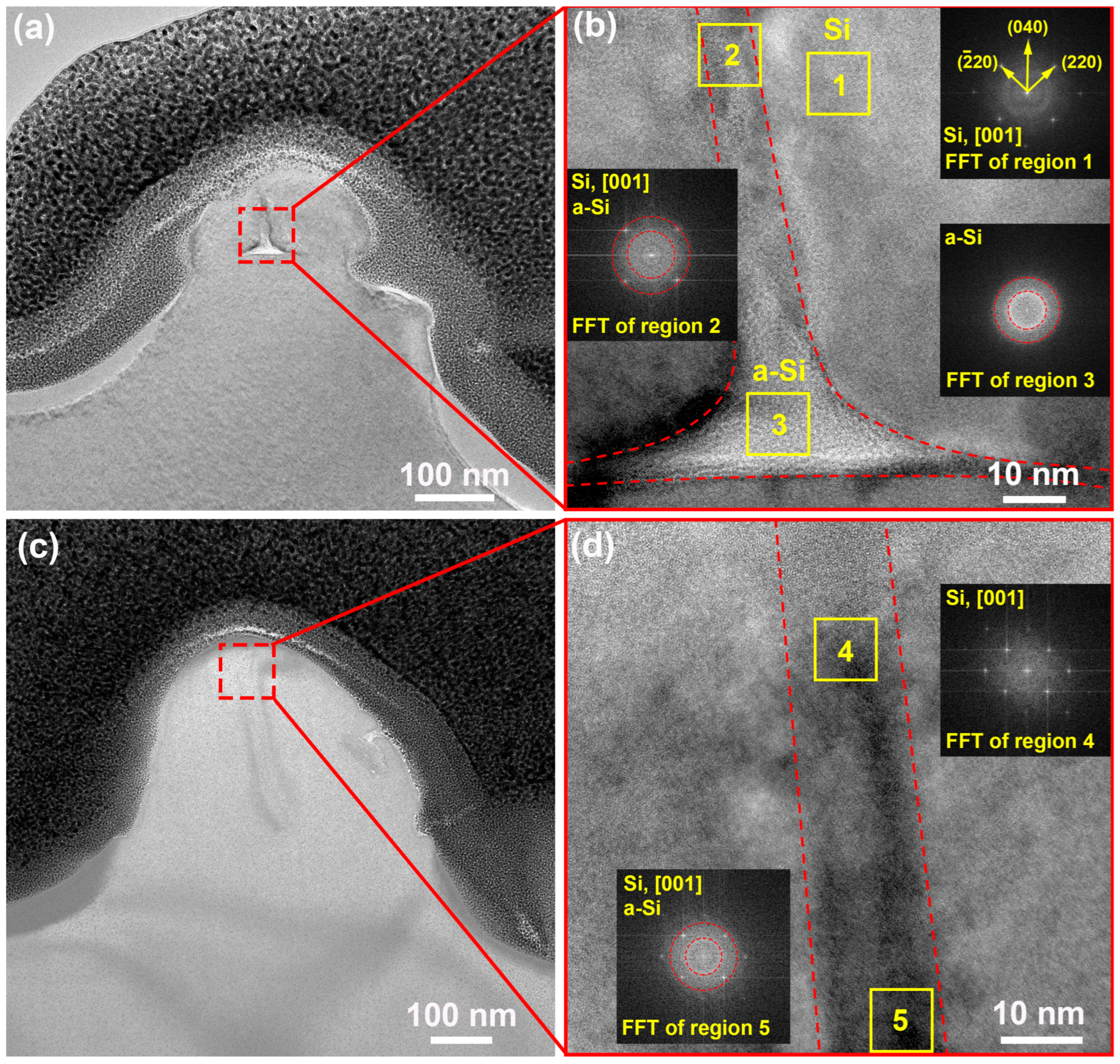
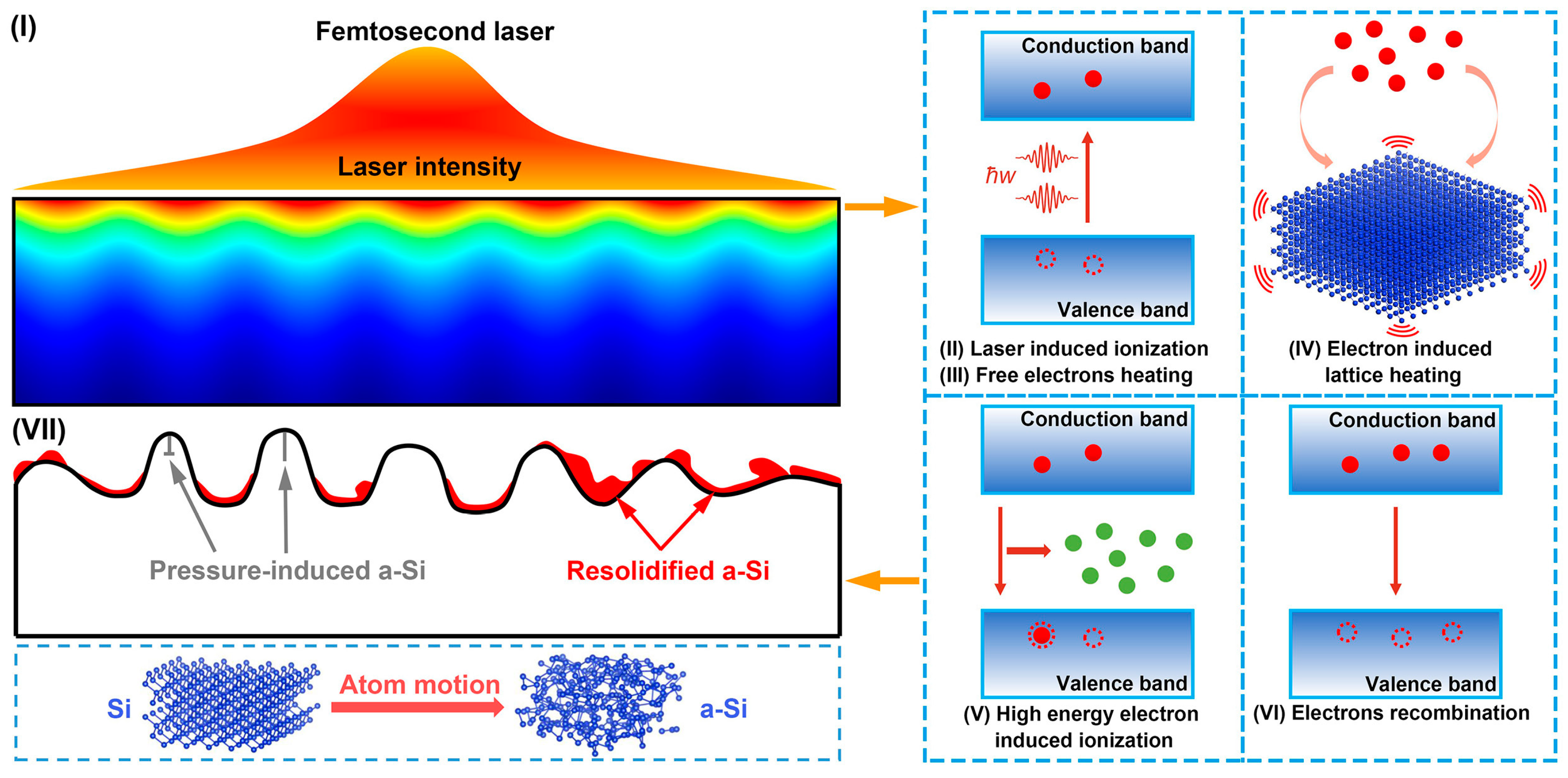
| Symbol | Nomenclature | Values | Unite |
|---|---|---|---|
| CA | Auger recombination coefficient | 3.8 × 10−43 | m6/s |
| Ce | Electron specific heat capacity | 3kBNe | J/(m3·K) |
| Cl | Lattice specific heat capacity | W/(m·K) | |
| c | Light speed | 3 × 108 | m/s |
| e | Electric charge | 1.6 × 10−19 | C |
| E0 | Bandgap energy | eV | |
| Je | Electron generation | (m3·s)−1 | |
| ke | Electronic thermal conductivity | W/(m·K) | |
| kl | Electronic thermal conductivity | J/(m3·K) | |
| m* | Effective optical mass | 1.64 × 10−31 | kg |
| Nt | Threshold density for electron-photon coupling | 6.02 × 1026 | m−3 |
| N0 | Total valance band density | 2 × 1029 | m−3 |
| n0 | Atomic density of Si | 5 × 1028 | m−3 |
| Pe | Auger recombination | m−3 | |
| tp | Pulse duration | 300 | fs |
| μe | Carrier mobility | m2·V−1·s−1 | |
| Carrier collision frequency | 7.87 × 1014 | Hz | |
| λ | Wavelength | 1030 | nm |
| Laser angular frequency | 2πc/λ | s−1 | |
| Plasma frequency | s−1 | ||
| Energy coupling rate between electron and lattice | W/(m3·K) | ||
| Electron-photon coupling time | s | ||
| Minimum electron-photon coupling time | 2.4 × 10−13 | s | |
| Minimum Auger recombination time | 6 × 10−12 | s | |
| Modulation amplitude | 0.15 | - | |
| One-photon absorption | 1.021 × 105 | m−1 | |
| Two-photon absorption | 1 × 10−10 | m/W | |
| Impact ionization coefficient | s−1 |
Publisher’s Note: MDPI stays neutral with regard to jurisdictional claims in published maps and institutional affiliations. |
© 2022 by the authors. Licensee MDPI, Basel, Switzerland. This article is an open access article distributed under the terms and conditions of the Creative Commons Attribution (CC BY) license (https://creativecommons.org/licenses/by/4.0/).
Share and Cite
Liu, Y.; Ding, Y.; Xie, J.; Chen, M.; Yang, L.; Lv, X.; Yuan, J. Research on Monocrystalline Silicon Micro-Nano Structures Irradiated by Femtosecond Laser. Materials 2022, 15, 4897. https://doi.org/10.3390/ma15144897
Liu Y, Ding Y, Xie J, Chen M, Yang L, Lv X, Yuan J. Research on Monocrystalline Silicon Micro-Nano Structures Irradiated by Femtosecond Laser. Materials. 2022; 15(14):4897. https://doi.org/10.3390/ma15144897
Chicago/Turabian StyleLiu, Yanan, Ye Ding, Jichang Xie, Mingjun Chen, Lijun Yang, Xun Lv, and Julong Yuan. 2022. "Research on Monocrystalline Silicon Micro-Nano Structures Irradiated by Femtosecond Laser" Materials 15, no. 14: 4897. https://doi.org/10.3390/ma15144897
APA StyleLiu, Y., Ding, Y., Xie, J., Chen, M., Yang, L., Lv, X., & Yuan, J. (2022). Research on Monocrystalline Silicon Micro-Nano Structures Irradiated by Femtosecond Laser. Materials, 15(14), 4897. https://doi.org/10.3390/ma15144897








